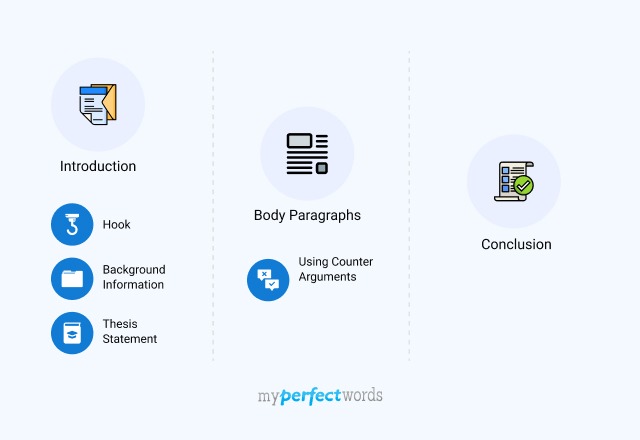Argumentative Essay Outline - Classic Pattern
A basic argumentative essay outline follows the same structure as any other type of essay. The difference lies in the content of the body paragraphs.
Unlike a persuasive essay, where the focus is on convincing the reader through emotional appeals, the argumentative essay presents the argument.
Some paragraphs introduce your own argument, while others state the opposing arguments and their refutations.
Here is a sample outline template you could follow for writing your essay:
Argumentative Essay Outline Template Topic
_________________________________________________________________________________
· (Topic Sentence) _________________________________________________________________________________ · (Evidence / Sources)
· (Topic Sentence) _________________________________________________________________________________ · (Evidence / Sources)
· (Topic Sentence) _________________________________________________________________________________ · (Evidence / Sources)
_________________________________________________________________________________ |
Steps to Write an Argumentative Essay Outline
Writing an argumentative essay outline involves organizing your ideas logically to present your argument effectively.
Here are the steps to create a complete outline, along with examples:
Step 1: Choose a Topic and Develop a Thesis Statement
The first step in writing an outline is selecting a clear, debatable topic that interests you and is relevant to your audience. Check out our argumentative essay topics blog for a wealth of ideas.
Once you have your topic, you need to develop a thesis statement. The thesis statement should clearly express your position on the topic and outline the main points you will use to support your argument.
Note to Remember: Consider the type of argument you are presenting—whether it's Classical, Rogerian, or Toulmin—when structuring your essay. Each type of argument has a specific structure and approach that can influence how you organize your essay.
Step 2: Structure Your Introduction
Outline these points for your essay introduction:
- Hook: Open with an engaging statement or question to capture the reader’s interest.
- Background Information: Give context to the topic.
- Thesis Statement: State your main argument.
Step 3: Extract Key Points for Body Paragraphs
Each body paragraph should focus on one main idea that supports your thesis. Follow these instructions to create effective body paragraphs:
- Topic Sentence: Begin with a clear topic sentence that states the main idea of the paragraph. This sentence should directly relate to one of the points mentioned in your thesis statement.
- Evidence: Provide evidence to support your topic sentence. This can include statistics, research findings, expert opinions, or real-life examples.
- Explanation: Explain how the evidence supports your topic sentence and ties back to your thesis. Clarify the significance of the evidence and how it strengthens your argument.
- Transition: Use transition words in between paragraphs. This helps maintain the flow of your essay and prepares the reader for the next point.
Step 4: Gather Counterarguments and Rebuttals
- Identify Counterarguments: Recognize potential objections to your thesis to understand the opposing viewpoint.
- Research Counterarguments: Gather evidence and information that supports the opposing stance or critiques your argument.
- Rebuttal Strategy: Develop responses that logically refute counterarguments using additional evidence or alternative perspectives.
Step 5: Outline Conclusion
- Restate Thesis: Summarize your main argument.
- Summarize Key Points: Briefly recap the main points discussed in the body paragraphs.
- Call to Action or Final Thought: Encourage the reader to take action or ponder the implications of your argument.
Argumentative Essay Outline Examples
Here are some argumentative essay outline example pdf you can follow to write an argumentative essay:
Need some sample essays to get a better idea? Give our blog on argumentative essay examples a read to find inspiration!
The Bottom Line!
We've covered all the essential elements of structuring your argumentative essay. With this guide, you're now well-prepared to craft a compelling essay that effectively presents your viewpoint and supports your argument with evidence.
Remember the key components: the introduction that hooks your reader, a clear thesis statement, well-organized body paragraphs, counterarguments, and a strong conclusion. Don't forget to cite your sources properly to give credibility to your work.
If you are unable to craft a perfect outline, you can always seek the help of an expert and professional essay writer at MyPerfectWords.com.
Our affordable argumentative essay writing service can help you write a top-notch argumentative paper. Our skilled writers conduct research to find facts and evidence to support your claim and write an original essay according to your needs.
So place your 'do my essays' request today and recieve expert assistance!




-9387.jpg)

